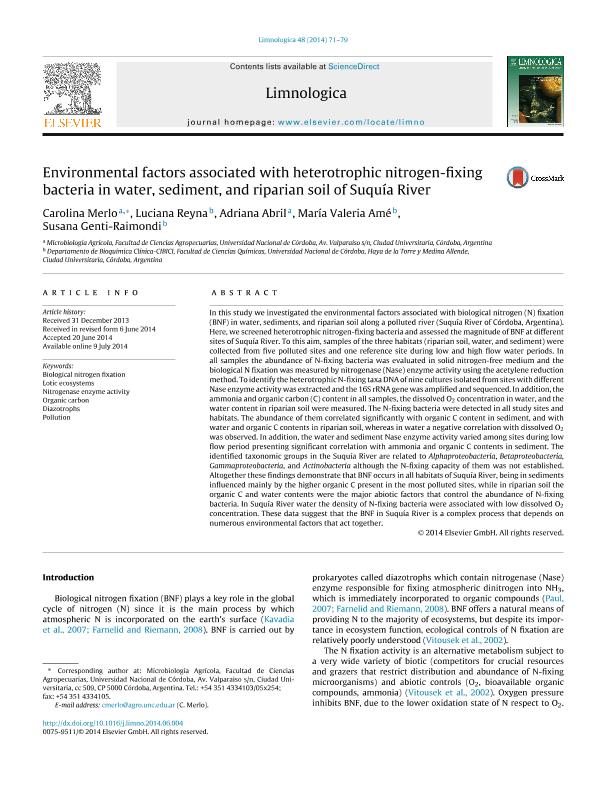Artículo
Environmental factors associated with heterotrophic nitrogen-fixing bacteria in water, sediment, and riparian soil of Suquía River
Fecha de publicación:
07/2014
Editorial:
Elsevier Gmbh
Revista:
Limnologica
ISSN:
0075-9511
Idioma:
Inglés
Tipo de recurso:
Artículo publicado
Clasificación temática:
Resumen
In this study we investigated the environmental factors associated with biological nitrogen (N) fixation (BNF) in water, sediments, and riparian soil along a polluted river (Suquía River of Córdoba, Argentina). Here, we screened heterotrophic nitrogen-fixing bacteria and assessed the magnitude of BNF at different sites of Suquía River. To this aim, samples of the three habitats (riparian soil, water, and sediment) were collected from five polluted sites and one reference site during low and high flow water periods. In all samples the abundance of N-fixing bacteria was evaluated in solid nitrogen-free medium and the biological N fixation was measured by nitrogenase (Nase) enzyme activity using the acetylene reduction method. To identify the heterotrophic N-fixing taxa DNA of nine cultures isolated from sites with different Nase enzyme activity was extracted and the 16S rRNA gene was amplified and sequenced. In addition, the ammonia and organic carbon (C) content in all samples, the dissolved O2 concentration in water, and the water content in riparian soil were measured. The N-fixing bacteria were detected in all study sites and habitats. The abundance of them correlated significantly with organic C content in sediment, and with water and organic C contents in riparian soil, whereas in water a negative correlation with dissolved O2 was observed. In addition, the water and sediment Nase enzyme activity varied among sites during low flow period presenting significant correlation with ammonia and organic C contents in sediment. The identified taxonomic groups in the Suquía River are related to Alphaproteobacteria, Betaproteobacteria, Gammaproteobacteria, and Actinobacteria although the N-fixing capacity of them was not established. Altogether these findings demonstrate that BNF occurs in all habitats of Suquía River, being in sediments influenced mainly by the higher organic C present in the most polluted sites, while in riparian soil the organic C and water contents were the major abiotic factors that control the abundance of N-fixing bacteria. In Suquía River water the density of N-fixing bacteria were associated with low dissolved O2 concentration. These data suggest that the BNF in Suquía River is a complex process that depends on numerous environmental factors that act together.
Archivos asociados
Licencia
Identificadores
Colecciones
Articulos(CCT - CORDOBA)
Articulos de CTRO.CIENTIFICO TECNOL.CONICET - CORDOBA
Articulos de CTRO.CIENTIFICO TECNOL.CONICET - CORDOBA
Articulos(CIBICI)
Articulos de CENTRO DE INV.EN BIOQUI.CLINICA E INMUNOLOGIA
Articulos de CENTRO DE INV.EN BIOQUI.CLINICA E INMUNOLOGIA
Citación
Genti de Raimondi, Susana; Amé, María Valeria; Abril, Adriana; Reyna, Luciana; Merlo, Carolina; Environmental factors associated with heterotrophic nitrogen-fixing bacteria in water, sediment, and riparian soil of Suquía River; Elsevier Gmbh; Limnologica; 48; 7-2014; 71-79
Compartir
Altmétricas




